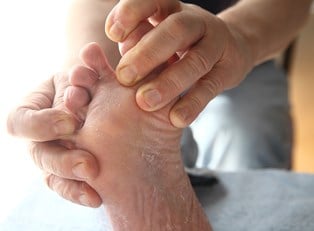Foot fungus, often referred to as athlete's foot because of its frequent occurrence among athletes, is a common fungal infection of the foot that usually begins between the toes. However, it can also easily spread to the soles and other parts of the foot. Through contact with the infected foot, hands and other body parts may become infected as well.
Here is a look at what you need to know about this condition—including its causes, symptoms, and treatments.
What causes foot fungus?
Foot fungus is a microorganism that feeds on dead skin cells and is caused sweaty feet being kept inside socks or shoes for extended periods of time. The hot, wet environment is perfect for foot fungus to appear, grow, and thrive.
Because foot fungus is very contagious, it may be contracted by having direct contact with an infected person. However, it can also be spread by walking barefoot in places where others with it have walked or by sharing towels and bedding with them. Some of the most common areas that may be contaminated with foot fungus are showers, nail salons, pool areas, and gyms.
Who is at risk for foot fungus?
Anyone can become infected with foot fungus. However, evidence shows that certain groups have a greater risk. They include:
- Men
- Athletes
- People who wear wet socks or tight shoes
- People who share cleaning or bedding materials with others
- People who walk barefoot
- People with weakened immune systems
- People with diabetes.
What are the symptoms of foot fungus?
The symptoms of foot fungus are quite hard to miss. They may include rashes and bumps on the feet, skin between the toes with a cheesy look and a foul odor, and constant itching. Despite the itching, an infected individual should try not to scratch the affected area because it can spread the infection and leave the skin raw. Some types of foot fungus may also cause dry, scaled skin to form, which can spread as well.
Why is it important to treat foot fungus?
If an infected individual is not suffering from the most irritating symptoms, he or she may believe that foot fungus is not a big deal and not seek treatment. However, this is actually a bad idea. Because it is very contagious, the longer someone is infected with foot fungus, the higher the likelihood it will be spread others, and these new carriers may have a more severe reaction.
Untreated foot fungus can also cause abrasions and bleeding of the skin, which may lead to cellulitis, a non-contagious bacterial infection. This is a particularly serious issue for people with diabetes and others with compromised immune systems. If their cellulitis does not respond well to antibiotics, which is highly possible due to their weakened immune systems, dead tissue can develop, possibly resulting in the need for amputation.
How is foot fungus treated?
There are numerous over-the-counter treatments for foot fungus. They include antifungal powders, lotions, sprays, and ointments. However, sometimes an infection is too advanced and may not respond to over-the-counter treatment, or the infection may recur. In that situation, a doctor's visit will be necessary. During the appointment, the doctor may ask several questions, do an examination to pinpoint the cause of the symptoms, and scrape skin from the affected area for further analysis. For potentially serious infections, doctors may prescribe antifungal medication.
How is foot fungus prevented?
There are numerous ways to avoid foot fungus infections. One way is by not walking barefoot in shared areas, especially in bathrooms. However, wearing flip-flops is a simple solution to this problem. Another way to avoid getting foot fungus is by removing wet socks or shoes. Shoes should also be switched regularly, and they should never be shared. Additionally, antifungal over-the-counter treatments may also be used daily as a preventative measure.



